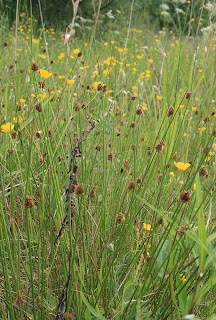


Rushes may not be such spectacular plants as orchids but they played a part in the lives of our ancestors which would be almost unimaginable today.
There are numerous species of Rush but three of the larger species are very common throughout the UK (and the Mersey Valley) and tend to grow in either shallow water or where the ground is poorly drained. These three species are: Soft Rush (Juncus effusus), Compact Rush (J. conglomeratus) and Hard Rush (J. inflexus).
These all form large clumps composed of numerous cylindrical stems. Each stem tapers to a point at the top. The flower-head appear to erupt from the side of the stem about three-quarters of the way up.
In the Soft Rush (top picture) the stem is smooth and a uniform glossy green. If the stem is split open it is found to contains a uniform, white pith (a bit like a solidified, dense foam). The flower-head (i.e. the ‘inflorescence’) consists of many tiny, yellowish brown flowers. When examined with a hand lens each flower is seen to be rather lily-like with six petal-like structures (‘tepals’), six stamens (male, pollen producing organs) and three stigmas (female parts); these flowers are wind-pollinated.
In the Compact Rush (middle picture) the stem is ridged, rather greyish-green in colour and not glossy. The stem contains a continuous, white pith. The inflorescence is very compact with the flowers jammed close together and close to the stem.
In Hard Rush (bottom picture) the stem is ridged and is a noticeably dull, glaucous, greyish-green colour. The pith inside the stem is chambered and not continuous. The inflorescence is considerably more diffuse than those of Soft Rush and Compact Rush.
In the Middle Ages rushes were used as floor covering. In those days poor people lived in hovels with beaten earth floors and the rich lived in castles and manor houses with stone floors. Strewn rushes were found to be a cheap and effective way of softening such harsh surfaces and in keeping them clean. According to the historian, Dorothy Hartley (1), “In the feudal system there would be special official rushcutters. Rushes were cut, drained and loaded into great deep baskets, carried shoulder high between two men, to be delivered to the ‘rush women’, who did the strewing and were supposed to clean out the old rushes before they put down the fresh.”
Rushes were also used for lighting purposes. It’s difficult to imagine, now, what life was like before electric lighting. In the summer people often went to bed when it got dark and got up when the sun returned in the morning. But coping with long, dark winter nights must have been a trial. The rich used candles – but these were expensive and, from the beginning of the 18th century on, were even taxed. The poor used ‘rush lights’. These were made by peeling the stems of Soft Rushes until only a long thin strip of outer skin was left to act as a support. The pith was then soaked in animal fat. The fat loaded taper thus produced was held in a spring loaded clamp and could be burned to produce (what must have been) a rather dim, smoky light.
The great 18th century, Hampshire naturalist, Gilbert White (2) gives more detail: “[The] rushes are in best condition at the height of summer; but may be gathered, so as to serve the purpose well, quite on to autumn. It would be needless to add that the largest and longest are best. Decayed labourers, women and children make it their business to procure and prepare them. As soon as they are cut they must be flung into water, and kept there; for otherwise they will dry and shrink and the peel will not run. At first a person would find it no easy matter to divest a rush of its peel or rind, so as to have one regular, narrow, even rib from top to bottom that may support the pith: but this, like other feats, soon becomes familiar even to children ... When these junci are thus prepared, they must lie out on the grass to be bleached, and take dew for some nights, and afterwards be dried in the sun.
Some address is required in dipping these rushes in the scalding fat or grease; but this knack also is to be attained by practice.”
He goes on to relate how bacon fat was often used for the purpose of dipping the rushes but how this could be improved upon by adding beeswax or mutton suet. He found that a “good rush” measuring, “two feet four inches and a half” burnt for, “only three minutes short of an hour”. He estimated that a poor family could purchase five and a half hours of, “comfortable light” for a farthing (a quarter of an old penny).
Give me electric lights any day!
Dave Bishop, June 2009
References:
1. ‘The Land of England’ by Dorothy Hartley, Macdonald and Jane’s, 1979.
2. ‘The Natural History of Selborne’ by Gilbert White, Penguin Books Edition, 1977 (first pub. 1788 – 9).



No comments:
Post a Comment